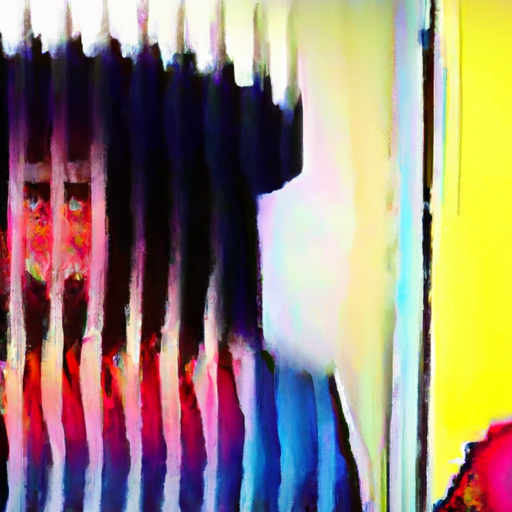-
Table of Contents
- NFT Art: A Game Changer in the Art World and Its Design Implications
- Introduction
- What are NFTs?
- The Rise of NFT Art
- Design Implications of NFT Art
- 1. Redefining Ownership and Authenticity
- 2. Exploring New Artistic Mediums
- 3. Challenges of Sustainability
- 4. Copyright and Intellectual Property
- Case Studies
- 1. CryptoPunks
- 2. NBA Top Shot
- Conclusion
NFT Art: A Game Changer in the Art World and Its Design Implications
Introduction
The art world has undergone a significant transformation with the emergence of Non-Fungible Tokens (NFTs). NFTs have revolutionized the way artists create, sell, and own digital art, opening up new possibilities and challenges for both artists and designers. In this article, we will explore the concept of NFT art, its impact on the art world, and the design implications it brings along.
What are NFTs?
NFTs are unique digital assets that are stored on a blockchain, typically using Ethereum as the underlying technology. Unlike cryptocurrencies such as Bitcoin, which are fungible and can be exchanged on a one-to-one basis, NFTs are indivisible and cannot be exchanged on a like-for-like basis. Each NFT has a unique identifier that distinguishes it from other tokens, making it one-of-a-kind and irreplaceable.
The Rise of NFT Art
NFT art has gained significant traction in recent years, with artists and collectors embracing this new form of digital ownership. The ability to prove authenticity and ownership of digital art has been a long-standing challenge, and NFTs provide a solution to this problem. By tokenizing their artwork, artists can create scarcity and establish provenance, which adds value to their creations.
One of the most notable examples of NFT art is the digital artwork “Everydays: The First 5000 Days” by Beeple, which sold for a staggering $69 million at a Christie’s auction. This sale not only showcased the potential of NFT art but also sparked a global conversation about the future of digital art and its value.
Design Implications of NFT Art
1. Redefining Ownership and Authenticity
NFTs have redefined the concept of ownership and authenticity in the art world. Traditionally, physical artworks were considered valuable due to their scarcity and provenance. However, with NFTs, artists can create scarcity in the digital realm by issuing limited editions or even unique pieces. This shift in perception has implications for designers who need to consider how to visually represent ownership and authenticity in the digital space.
2. Exploring New Artistic Mediums
NFTs have opened up new possibilities for artists to explore and experiment with digital mediums. Artists can now create interactive and immersive experiences that go beyond static images. For example, the artist Mike Winkelmann, known as Beeple, has been creating daily digital artworks for over a decade, showcasing the potential of NFTs to enable continuous artistic expression.
3. Challenges of Sustainability
The environmental impact of NFTs has been a topic of concern. The energy consumption associated with blockchain technology, particularly Ethereum, has raised questions about the sustainability of NFT art. Designers need to consider the environmental implications of their work and explore alternative blockchain technologies that are more energy-efficient.
4. Copyright and Intellectual Property
NFTs have also raised questions about copyright and intellectual property in the digital art world. While NFTs provide a way to prove ownership, they do not necessarily address issues of copyright infringement or unauthorized use of digital art. Designers need to consider how to protect the rights of artists and ensure that their work is not misused or plagiarized in the digital space.
Case Studies
1. CryptoPunks
CryptoPunks is one of the earliest and most successful examples of NFT art. Created by Larva Labs, CryptoPunks are 10,000 unique 24×24 pixel art characters that can be bought, sold, and owned as NFTs. Each CryptoPunk has its own distinct features, making them highly collectible. The success of CryptoPunks has paved the way for other NFT projects and demonstrated the demand for unique digital assets.
2. NBA Top Shot
NBA Top Shot is an NFT platform that allows users to buy, sell, and trade officially licensed NBA collectible highlights. Each highlight is minted as an NFT, making it a unique and valuable digital asset. NBA Top Shot has gained immense popularity, attracting millions of users and generating millions of dollars in sales. This case study highlights the potential of NFTs to disrupt not only the art world but also other industries.
Conclusion
NFT art has emerged as a game changer in the art world, providing artists with new opportunities to monetize their digital creations and establish ownership in the digital realm. The design implications of NFT art are vast, ranging from redefining ownership and authenticity to exploring new artistic mediums. However, challenges such as sustainability and copyright infringement need to be addressed to ensure the long-term success and ethical use of NFT art.
As the art world continues to evolve, NFTs will undoubtedly play a significant role in shaping its future. Artists and designers must embrace this new technology and explore its potential to create innovative and meaningful digital experiences. By understanding the impact of NFT art and its design implications, we can navigate this exciting and transformative landscape with creativity and responsibility.
